Friday, December 21, 2007
Tuesday, November 20, 2007
Thursday, October 18, 2007
Something more people should know about:
Every once in a great while does something really make you scratch your head with genuine curiosity. One of those things for me, which I am more than happy to share with everyone out there is the enigma that is Macho Man Randy Savage's album BE A MAN (2003). Yes, that's right, the voice of slim-jims has a CD out. Not just any genre either, a RAP-METAL CD.
I first heard Be A Man early on in my collegiate career where I discovered it on the school's local direct connect hub (Remember that?). My morbid curiosity was what lead me to click that download button. What I got was certainly not what I expected.
Part of what makes this so perplexing is that the record itself isn't half bad when looked at in its context. The production isn't shoddy - its got original beats, some neat samples, and what sound like real singers/rappers accompanying him. The content is also like a modern rap CD--- hype men, beef tracks (against former friend Hulk Hogan in the title track of the CD)---

look at the lyrics here:
They call you Hollywood (hugh hugh) don't make me laugh
Cuz your movies and your actin' skills are both trash
Your movies straight to video the box office can't stand
While I got myself a feature role in Spider Man
sensitive dude track (What's that All About?), the "dead homie song" (My Perfect Friend - for Curt "Mr. Perfect" Henning - subtle homo-eroticism - check- does it make you feel sad - yes.) party song (Macho Thang) ... etc.
And the even weirder thing is that Macho Man ain't half bad at rapping. I don't know if he took a lot of lessons, payed someone to write the tracks - I'm totally in the dark. In fact I don't know how he got the idea in his head in the first place. The lyrics are almost laughable at times, but Savage delivers them with his normal gruff intensity.

I also wonder who was the intended audience for this release? Insane Clown Posse fans (Juggalos)? WWE fans? Rap fans? Metal fans? I am really intruiged by all these questions, like what are his concerts like? Who goes? Is this vaguely racist? Why am I listening to this? Is this serious or tongue in cheek? Where did he find these (decent) rappers to accompany him?
Oh it makes my brain hurt. Well here are some tracks for you to decide for your self. And if you have any answers to any of these questions or some of your own, please let me know!
[try to] ENJOY!
Intro:
What's That All About?
Ru Ready
Be a Man
PS: Sorry for the delay in posts, it's mid-term season in the real world. Also stay tuned in for OWEN and more Brunettes action. coming soon.
Thursday, October 11, 2007
The Good Life in NYC
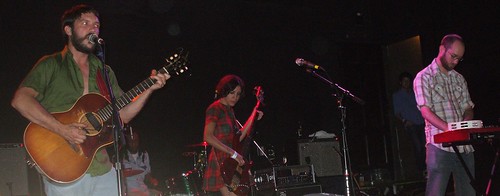
Last week the mopey, sensitive kids you remember from high school (myself included i suppose) - converged on Bowery Ballroom for a cathartic evening with one of the most jarring songwriters in indie music today. Tim Kasher's voice is a familiar one to man, having fronted some seminal bands in the genre - Slowdown Virgina, Cursive, (a little bit in) Commander Venus, and his most personal project the Good Life.

The Good Life has
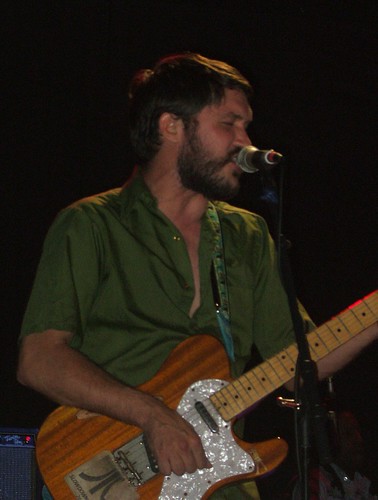 evolved from a more solo - acoustic, electronic venture, to a cohesive band with a full, lush sound. They are touring in support of their fantastic new release Help Wanted Nights on Saddle Creek. So while the focus of the night was playing lots of cuts of the new record, there was also plenty of time given to his now classics. Watching Kasher on stage is where the magic of the Good Life manifests. He stomps around like a caged animal (in a very non-threatening way of course) and lets him self go as he spits (literally) and sprays the lyrics as loud as he can. He also has the rare power to pull back and subdue himself.
evolved from a more solo - acoustic, electronic venture, to a cohesive band with a full, lush sound. They are touring in support of their fantastic new release Help Wanted Nights on Saddle Creek. So while the focus of the night was playing lots of cuts of the new record, there was also plenty of time given to his now classics. Watching Kasher on stage is where the magic of the Good Life manifests. He stomps around like a caged animal (in a very non-threatening way of course) and lets him self go as he spits (literally) and sprays the lyrics as loud as he can. He also has the rare power to pull back and subdue himself.However, an uglier (literally) side of the show exposed itself almost immediately through the form of the loudest, worst voiced, most obnoxious girl in the world. Standing directly behind me. She really seemed to want to be louder than Kasher himself. I really enjoy more intimate shows because the odds of getting someone like her there are considerably lower. While I was recording these tracks she was there making her lame presence felt. Everyone around her (myself included) was put on edge by her truly selfish and childish behavior. On the recording of O'rourks (a personal fav. song) I even spoke directly to her telling her to chill out. Listen for the results.
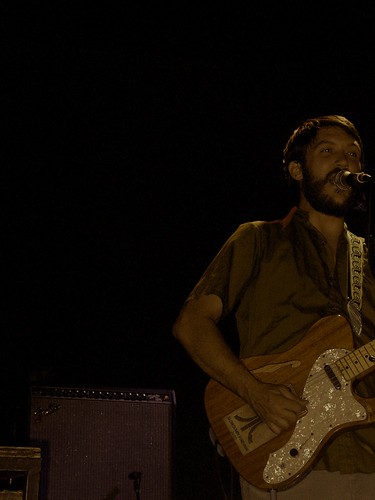
Lady, if youre out there, and reading this, GO FUCK YOURSELF and never go to another concert again!
whew, talk about cathartic.
Regardless I still had a great time and seeing Kasher and the rest of the Good Life live and completely in their element really was a treat.
Here are some tracks:
New Friend
O'Rourks 1:20 AM (LAME GIRL MIX)
Heartbroke
Album of the Year
Don't Let Go
ALL PHOTOS by Caroline Scott ©2007
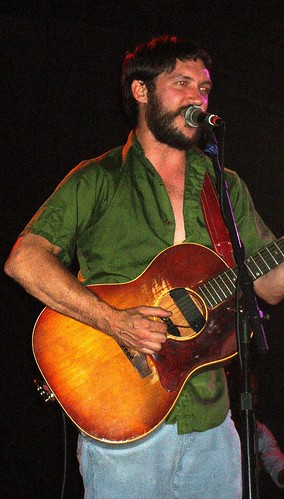

Sunday, October 7, 2007
Adrian Tomine's Shortcomings...
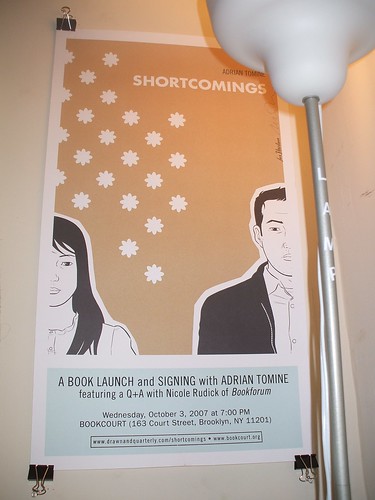
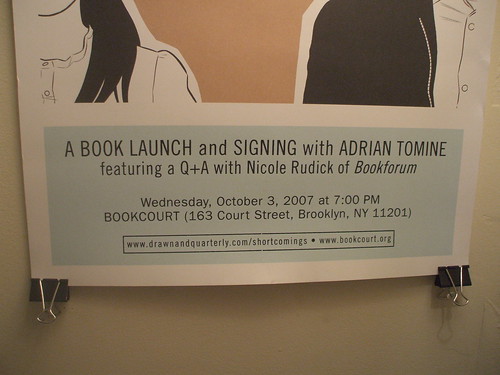
Adrian Tomine spoke at Bookcourt in Brooklyn last Thursday- it was quite a thrilling and rare occasion to see an artist elaborate on what, in this case he spent the last five years completing. The collection of Shortcomings in a beautiful hardcover volume truly establishes Tomine's dominance of the genre of comic books while growing and touching on territory that is usu
 ally foreign in his work.
ally foreign in his work.The story, which is familiar to the Optic Nerve reader (#9-11), follows its tortured protagonist Ben Tanaka and steadily sinking (relation)ship with his girl friend Miko. Sounds like the usual Tomine story, however, he manages to insert some larger messages about modern society, racial & sexual stereotypes, and even American Apparel. This is a bi-coastal story of a man grappling with his identity as an Asian American and as a man looking for companionship. Unfortunately he manages to look in some of the wrong places all together, and while being the main character is not without his flaws. The beautiful image of Miko on a pillowcase is the culmination of the other female characters he's featured on patterned pillowcases (see Optic Nerve #4 "Hazel Eyes" & "Break-Up Part 2" in Scrapbook.).

Tomine's drawings and the composition of his panels has never been better. He offers many fresh angles while sticking to rather conventional comic set up. By sticking to the rules he manages to come up with more interesting ideas to get around the constraints he set up for himself. Tomine revealed that he did not use narration text to describe actions, a very intense decision to commit to. He accomplished this so smoothly that I wasn't even aware until he mentioned it in the interview conducted by Nicole Rudick.
The two had a good chemistry and she asked many of the probing questions that I'm sure were on the mind of many in attendance. He also accepted questions from the audience which ran the gambit from banal (what music do you listen to when working?) to the obtuse (How do you do you make your characters sound so realistic?). When he signed my lithograph & poster I asked him my question which was in regards to the novelistic and cinematic elements to his work if he would ever do either a novel or a movie? He replied that he had no plans to flex his novel writing muscles, but he insinuated that he would do a movie for the right price.
This collection is certainly worth purchasing for both the diehard fan as well as the person who is just getting into comics - as some one mentioned at the the Q & A - that Tomine is a "gateway comic" artist. The book is the result of Optic Nerve 9-11
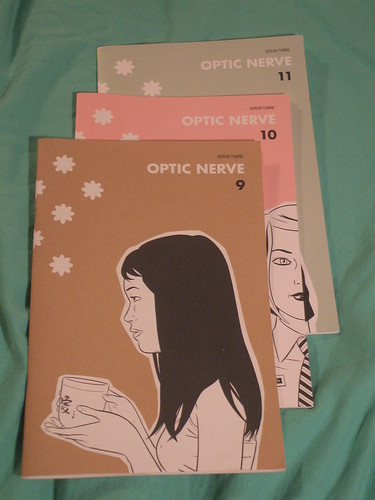 and for the more casual Tomine fan may be better in that form. The serial nature of it and the letters that Tomine publishes are priceless, plus the single issues are only 4 bucks each. However, don't be too quick to call Tomine a money grubber, these were originally envisioned as book in a final stage. Also by releasing it in Optic Nerve he gave the true comic fans, and small comic stores the chance to get ahead before regular bookstores and newspapers took notice. It gave readers a chance to see progress, however the response was that it took too long between stories.
and for the more casual Tomine fan may be better in that form. The serial nature of it and the letters that Tomine publishes are priceless, plus the single issues are only 4 bucks each. However, don't be too quick to call Tomine a money grubber, these were originally envisioned as book in a final stage. Also by releasing it in Optic Nerve he gave the true comic fans, and small comic stores the chance to get ahead before regular bookstores and newspapers took notice. It gave readers a chance to see progress, however the response was that it took too long between stories.The night was a great experience and it was amazing to be so up close and personal with Tomine. He was very nice and took his time signing each piece for the many people in attendance. I asked him for a sketch which he said he would do if I waited around (unfortunately I couldn't because right from there I ran over to Hoboken to see the Brunettes). One of the more brilliant promotional ideas for the comic is definitely the post cards that Ben finds of Miko printed in real life. It is a great way to illustrate the way that comic books are finding their place in the real world. Shortcomings is anything but.
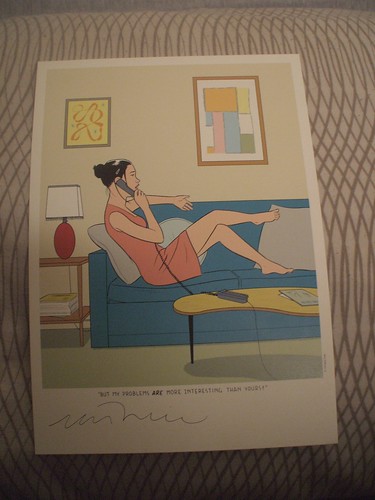
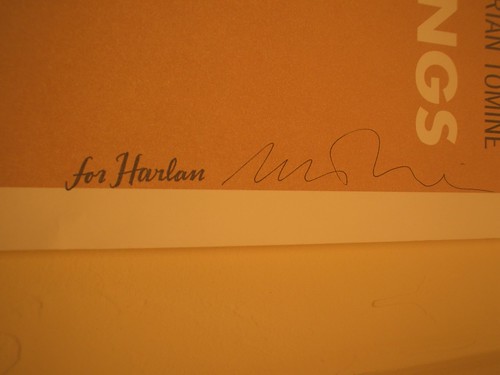
Saturday, October 6, 2007
News Update: Arcade Fire Burnt Out?
This is just some late-breaking news from Randalls Island in NYC where the Arcade Fire and LCD Soundsystem played for a massive crowd of fans on an indian summer evening: During the Arcade Fire's set Win Butler announced (hopefully exaggerated) that they are not going to be back to New York for "a few years." Now does this mean they are not going to tour at all? Are they on a musical hiatus? One can only speculate at this juncture, however, the show they put on tonight was spectacular with no holds barred. There was an ornate and complex light show and a larger than life set up on stage. My favorite moment was watching a drum be broken to bits in a fit of musical bliss by a couple members of the band.
All this to say that the show is what distracted me from putting up some great photos and audio of the good life, a review of Adrian Tomine's Shortcomings, and working on a future post on Randy Macho Man Savage (I'm not kidding.).
Well that's what's in store... keep your ear to the ground til then!

All this to say that the show is what distracted me from putting up some great photos and audio of the good life, a review of Adrian Tomine's Shortcomings, and working on a future post on Randy Macho Man Savage (I'm not kidding.).
Well that's what's in store... keep your ear to the ground til then!

Thursday, October 4, 2007
Perhaps the Cutest Band from Down Under...

The Brunettes (see the post below the sprawling Ellis bit to view their great video, for their great song, Her Hairagami Set, and read a bit about it) filled Maxwells up with their sweet tunes and good vibes. I had been anxiously anticipating making the trek the Jersey to get to see their Kiwi hijynx, live and in person, since hearing that they were embarking on a fall global tour. I was certainly not disappointed.
The band - who's figureheads- the impeccable Jonathan Bree, and the adorable Heather Mansfield - along with four of their good pals along for the ride (listen to the great introduction they have for one another, where the sound builds one instrument at a time when
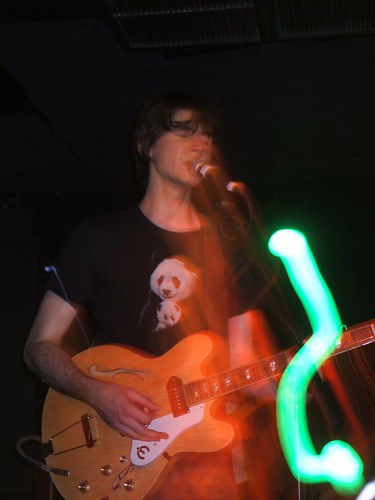 they, "form like voltron..." posted) really had their game tight in support of Structure and Cosmetics (out now on SUB-POP). The chemistry on stage was light and sweet between members as they traded banter, stories, and quips between one another and the small, but excited audience. Lots of smiling, synchronized hand movements, and general cheer ruled the set.
they, "form like voltron..." posted) really had their game tight in support of Structure and Cosmetics (out now on SUB-POP). The chemistry on stage was light and sweet between members as they traded banter, stories, and quips between one another and the small, but excited audience. Lots of smiling, synchronized hand movements, and general cheer ruled the set.While much of the new album's material took hold of the set, they also peppered it with an odd older tune (Holding Hands Feeding Ducks - see below) and the famed Mary Kate Ashely Olsen song. There was varied instrumentation as Heather would swap out keyboards for the clarinet, and then for the xylophone- not to discount the triangle, sax, trumpet, woodblock, and slide guitar which also made appearances. One key highlight from the performance was a two song long dance competition, which certainly inspired some crazy moves from a select few in the crowd. My only qualm was that I didn't get to a personal favorite of mine Cotton Candy... but I forgave them because you couldn't ask for a sweeter, less assuming group of musicians.
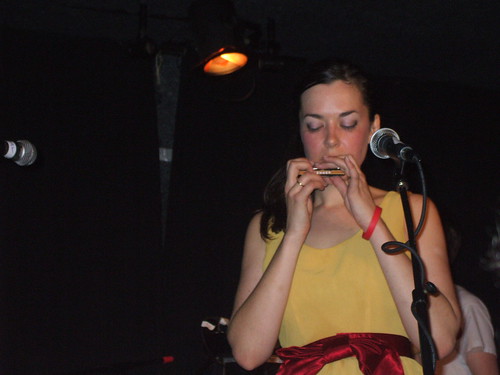
The Brunettes US tour continues for another couple weeks before they head off to Europe. I wish them all the best and to keep up the great work. Any one who can catch their performance it is certainly not to be missed. And for those of who you cant- check out these photos and selected recordings from the show.

ENJOY!
B A B Y
Her Hairagami Set
Wall Poster Star
Holding Hands Feeding Ducks (Band Intro!)
ALL PHOTOS By Caroline Scott ©2007.
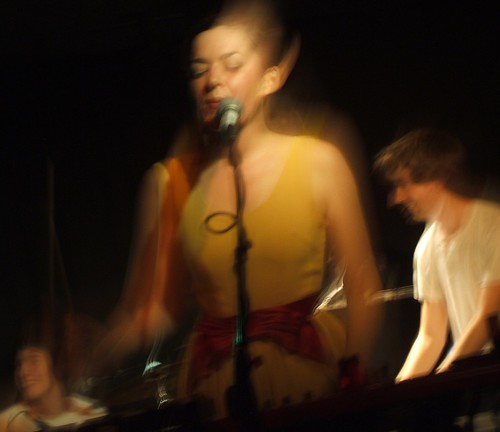



Disappear Here: A Closer Loot at Two Social Critics PART III

The thrilling conclusion:
Dostoevsky and Ellis share the feature that they are exploring the ways out of these modern conundrums. How salvation and transcendence can be reached despite all the shortcomings of the larger world. Dostoevsky places all his characters in situations where they have to suffer and hurt before they are redeemed. This is particularly the case in Crime and Punishment, The Idiot, and the Brothers Karamazov. In all of these texts he places the protagonists in situations where they must go through their days in a non-Catholic confessional nature, in which people get salvation through recognition. Their personal morality is higher than law. They will personally sacrifice for others. They are asexual beings that live for things larger than flesh. They are on this quest before they are even aware of it. Here is a quote from Brothers Karamazov in summation,
Gentlemen, we're all cruel, we're all monsters, we all make men weep, and mothers, and babes at the breast, but of all, let it be settled here, now, of all that I am the lowest reptile! I've sworn to amend, and every day I've done the same filthy things. I understand now that such men as I need a blow, a blow of destiny to catch them as with a noose, and bind them by
 a force from without. Never, never should I have risen of myself! but the thunderbolt has fallen. I accept the torture of accusation, and my public shame; I want to suffer and by suffering I shall be purified. Perhaps I shall be purified, gentlemen?
a force from without. Never, never should I have risen of myself! but the thunderbolt has fallen. I accept the torture of accusation, and my public shame; I want to suffer and by suffering I shall be purified. Perhaps I shall be purified, gentlemen?(Dostoevsky, The Brothers Karamazov)
Ellis has a much bleaker view on the outcomes of these personal quests for salvation. Clay from Less Than Zero is left a burnt out mess by the end of the story without any connection to his home town of Los Angeles or his former acquaintances. Patrick Bateman makes a heartfelt confession at the end of American Psycho where he is then laughed at and it is unclear as to whether or not he even committed any of the crimes he had just described; there is no catharsis. Rules of Attraction ends as it begins, in mid-sentence however on a note where all three of the characters involved in the love triangle realize that they will never truly know one another or anyone else on the planet.
While Ellis and Dostoevsky are very similar in many ways; they both gained fame at young age (Dostoevsky at 23 and Ellis published his first novel at a tender 19 years old), they both cover similar ethical and moral pitfalls, and both even have the same criticisms – being potboilers and churning out books to make a buck. There are some subtle differences other than time and place that separate them. Ellis tends to write about the effect of these issues on the higher stratas of society – the stockbrokers, the movie producers, the models, the college students. Dostoevsky was focused, for the first time in Russian history, on the lower class common folk who had never had their stories told before. Ellis also had the luxury of having Dostoevsky as a reference and an archetype to fall on and reference. Even despite these reasons, they still very much line up on the key components of being a social critic.
Whether o
 r not you agree with them or like them, the world needs the type of person who is able to step outside the confines of their surroundings – time and place- and look in and make a deeper statement on what it is that drives the human spirit. The eye of the author is able to truly take in the modern human condition in such an elegant way that it never truly loses relevance, even after the time it was written has come and gone. Ellis and Dostoevsky are not the end of this cycle either, for every generation there will be a voice of dissent that will make the people who read their work question the lives they are leading and for what purpose they are making their way through the world. I’ll conclude with a list of the most prominent reoccurring Ellis phrases from his books that seem to overlap with Dostoevsky’s world: “Disappear Hear“, “this is not an exit“, “we just slide down the surface of things“, and “Deal with it.“
r not you agree with them or like them, the world needs the type of person who is able to step outside the confines of their surroundings – time and place- and look in and make a deeper statement on what it is that drives the human spirit. The eye of the author is able to truly take in the modern human condition in such an elegant way that it never truly loses relevance, even after the time it was written has come and gone. Ellis and Dostoevsky are not the end of this cycle either, for every generation there will be a voice of dissent that will make the people who read their work question the lives they are leading and for what purpose they are making their way through the world. I’ll conclude with a list of the most prominent reoccurring Ellis phrases from his books that seem to overlap with Dostoevsky’s world: “Disappear Hear“, “this is not an exit“, “we just slide down the surface of things“, and “Deal with it.“
Tuesday, October 2, 2007
Disappear Here: A Look at Two Social Critics - Part II
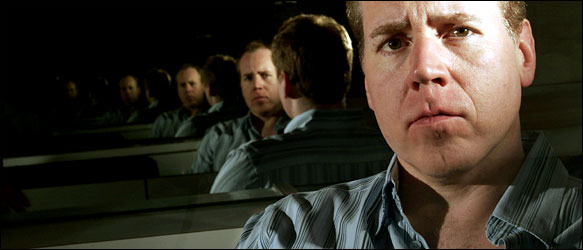
Round II:
Nihilism is a train of thought that was just emerging during Dostoevsky’s day and that people have been grappling with all the way through Ellis’ time. Coming from the Latin word Nihil meaning “nothing,” it is an ethos that isn’t even an ethos. The pillars of nihilism are that there is no higher being, no absolute truth, no absolute morality - one way to look at is that it is the death of empathy. This didn’t sit well with Dostoevsky’s Eastern Orthodox Christian beliefs. He seemed to try and dismantle it the most in his work The Idiot through the use of a good-hearted prince named Myshkin. The prince comes to represent a wholesome, pure, innocence in a world filled with phonies, liars, and people obsessed with just the outward appearance of things – he constitutes a “holy/tragic fool” – one who doesn’t know any better than to be good. Dostoevsky used him to show how people aren’t – thoughtful, caring, Christ like. He demonstrated this through his inability to actually function in society and then his eventual decline into madness. A quote that best captured this feeling takes place at a dinner party in which Myshkin expresses his grand love for nature as one of God’s many creations. Though his words inspires those around him they still think of him as an outisider, “I don't understand how one can walk by a tree and not be happy at the sight of it! Or to speak with a man and not be happy in loving him? … There are so many things at every step so beautiful." (Dostoevsky, The Idiot, Part IV, Chapt. 7)

Ellis also addresses this theme in his book the Rules of Attraction (in which he also directly references Notes from Underground). This is his take on the lives of American college students, particularly the archetypal North Eastern Liberal Arts schools (he himself wrote his first book at nineteen at Bennington College in Vermont.). In the book, which takes place in the fictional Camden College in New Hampshire, he tackles romance in the late 20th century through a loosely tied series of vignettes describing the same events from each of the characters own, self indulgent perspectives - all but one. Ellis has cast his holy fool in the form of a true romantic, a girl who is in love with Sean Bateman (yes – he’s Patrick’s little brother) who leaves beautiful and articulate notes in his mailbox about her need to be with him. Ellis writes her passages in all italics and this is a cue to his readers that it is her. When Sean fails to realize who was putting the notes in his box, she cannot bear the pain and kills her self in a touching and difficult scene,
I’m lying, in warm water, in a bathtub, in Sawtewll. I’m doing this because I know I’ll never have Him. I drag the razor firmly across the hot skin underwater and the flesh peels back quickly, blood jetting out, literally jetting out, from the bottom of my arm. I drag it cross the other wrist jaggedly, up and down, and the water turns pink. When I lift my arm up above the water blood gushes powerfully high and I have to place my wrist back under so I’m not splattered with it. I sit up, only slash at one ankle because the weakness drenches me and I lay back, the water turning impossibly red and then I start to dream, and I keep dreaming and its then that I’m not sure if this is really the thing to do. I can hear music coming from another house someplace and maybe I try to sing along with it, but as usual I find myself getting to the ending before it actually happens. Maybe I should have tried another route. The one that little man at the gas station in Phoenix advised, or shall I say urged on to or oww- guess what? No time. God jesus christ your my nothing savior.
(Ellis, Rules of Attraction, p 173)

This anonymous girl is a victim of this age in which romance and empathy are dead. Neither Ellis or Dostoevsky chose to prove this without sacrificing some of their own better characters.
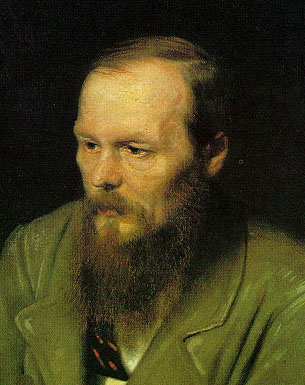
The functioning family unit is also a great canary in the mine as far as determining the over all health of a society’s ability to function with one another. These family ties are tackled head on in Dostoevsky’s final and classic novel The Brothers Karamazov. This book is the story of a parricide committed by one of four brothers (one is illegitimate and works as a servant.). This unique family situation plays out with violent consequences when the varied personalities of the brothers are brought to light. The analogy for the larger context of society seems to point at certain archetypes who’s roles play out in a new Russia without a Czar. Here is a key quote from the novel concerning one’s larger role in society/family, “Imagine that you are creating a fabric of human destiny with the object of making men happy in the end......but that it was essential and inevitable to torture to death only one tiny creature...And to found that edifice on its unavenged tears: would you consent to be the architect on those conditions? Tell me, and tell me the truth!”
Ellis deals with the family in a slightly different way where it has almost dissolved into the background of many of his character‘s lives. The privilege his characters seem to enjoy so much also leads to this empty feeling they get around their families. This is seen in almost all his works, including American Psycho, where Patrick Bateman, Ellis has said, is based on his take on his own father. (Needless to say, they didn’t have the best relationship.) Patrick and Sean from Rules of Attraction are also related and both have a shared hatred for their own father and one another – from a brief passage in Rules of Attraction written from Patrick Bateman’s perspective, “I try to remember when he started hating me, when I started reciprocating the feeling… He has nothing to say to me and I, in the end, have really nothing to talk about with him.“ (Ellis, Rules of Attraction, p. 239)

In Lunar Park, Ellis‘ fifth novel and first attempt at genre writing (it’s a horror story/fake memoir) he places a fictional version of himself as the title role, where he himself plays a father figure in the affluant suburbs outside of New York City. It is also Ellis‘ first time writing in a past tense narrative. Ellis directs his gaze at the suburban family and the secrets they all hide. He is also, through the magic of literature, able to connect with two of the characters he has also fathered – both Clay the protagonist from Less Than Zero and Patrick Bateman make their physical presence felt in the novel. This book takes a close look at Ellis’s own existential nausea and turns it into a ghost story about the post-9/11 world we live in.

Ellis also visits the topic of family relationships in his books Less Than Zero and Rules of Attraction. In Less Than Zero he makes the parents almost non-existent in their control over their children’s lives. They just sign checks and live out their own lives with their own affairs and drug problems. In Rules of Attraction this same dynamic is played out when one of the three main characters, Paul has to spend a weekend with his mother. She is shown as not much more than a pill popping ditz drowning away real life with martini after martini. This break down of the family unit is critical to understanding the way in which society is functioning.
To be concluded on Thursday. Stay tuned.
Monday, October 1, 2007
Disappear Here: A Closer Look at Two Social Critics - Part I
Here it is a for your reading pleasure- Dostoevsky Vs. Ellis
Russia in the mid-nineteenth century was a time and place of dramatic changes that unfolded over a very short amount of time. It was a landscape of a people who had to begin identifying and catching up with a rapidly modernizing world in which conflicting ideologies were being pitted against one another. One man who stood up and used his pen to voice his opinions on those changes and on the world he lived in; his name was Fydor Dostoevsky. Fast forward a hundred and thirty years to the continent of North America. Here other conflicts are brewing regarding human interaction, materialism, drug use, celebrity, terrorism, serial killers, college, and the suburbs ---- notably in the American cities of New York, Los Angeles, and any random college town. This time the man voicing the issues of the day is a daring wordsmith named Bret Easton Ellis.
These two literary thinkers have both blurred their works into the realm of social criticism by using their writing as a lens to look at the world in which they are living with a scathingly, satirical eye. Despite the time differences, they both look at the larger human issues that began to surface based on the circumstances of their respective times. They both critique the larger issues of what it is to be modern, man’s nihilistic tendencies, family relationships (and how they reflect the larger whole of humanity), and the ideal of salvation and transcendence over this world. They also both have been critiqued in similar ways, by people of their day, of being potboiler writers, having too many characters, loose narratives, and writing in the current/common vernacular. After reading the major texts of both authors the similarities became abundantly clear, and clearer yet with Ellis’ use of directly referencing Dostoevsky’s Notes from Underground to begin his book American Psycho:
Both the author of these Notes and the Notes themselves are, of course, fictional. Nevertheless, such persons as the composer of these Notes not only exist in our society, but indeed must exist, considering the circumstances under which our society has generally been formed. I have wished to bring before the public, somewhat more distinctly than usual, one of the characters of our recent past/ He represents a generation that is still living out its days among us. In the fragment entitled “Underground” this personage describes himself and his vies and attempts, as it were, to clarify the reasons why appeared and was bound to appear in our midst. The subsequent fragment will consist of the actual “notes,” concerning certain events in his life.
(preface, American Psycho, Dostoevsky)

This passage serves to illuminate the reader of what they are stepping into- right from the start they know they are on Dostoevsky-ian territory. It is cueing the reader up for certain things to stand out in order to understand, with more clarity, their current situation.
Even the concept of modernity itself is fair game for these authors to attack. Dostoevsky, like many Russian souls was grappling with a rapidly modernizing landscape. Almost over night Russia became torn between trying to forge a Western European identity – rife with capitalism, utilitarianism, Catholicism – and its Eastern Slavic Asian roots. Even this is reflected in Dostoevsky’s own life where he at an early time in his adult life showed some interest in the liberal radical groups that were making their way around Russia calling for change; it resulted in his near execution, four year long imprisonment, and five year Siberian Army stint. Rather than this punishment driving him further towards the left, it had the reverse effect and sent him into exploring deeper themes of spiritualism, psychological confusion, and existentialism through a lens of Slavophilia on a rapidly modernizing nation.

This theme of modernity shows its face in many of Dostoevsky’s key works where the characters he’s created, like the protagonist in Crime and Punishment, are testing out the limits of the newly modernized world. The story centers on Raskolnikov as a man who lives in one of the most Westernized cities in Russia, St. Petersburg. He is a student who plots and carries out a murder of a pawnbroker – thereby logically solving his money problems and ridding the world of an evil person. He quickly learns that this utilitarian thinking of straight logic doesn’t always lead to its rational ends. The novel plays out symmetrically, where the first three parts chronicle the crime and admitting, and the second three parts bring the reader through the punishment and eventual salvation. Dostoevsky tackles a world in which man is his own God and sets him up to fail, only to be redeemed after he suffers. From Chapter 2, “What if man is not really a scoundrel, man in general, I mean, the whole race of mankind-then all the rest is prejudice, simply artificial terrors and there are no barriers and it's all as it should be." (Dostoevsky, Crime and Punishment, Part I, Ch. 2) At the end Raskolnikov is redeemed by his confession and acceptance of his role under God. The dingy St. Petersburg becomes a strong symbol for what was considered progress of the day and Dostoevsky portrays it in such a negative light it is impossible to consider it a place of good and hope.

Fast forward in time and place, and this same scenery is played out in Ellis’ American Psycho. The New York City of the 1980’s is a far different New York than the dream of Rudy Giuliani’s today. It was a place where dark alleyways were not to be entered, people were just learning of AIDS, and the gap between rich and poor was at its largest. American Psycho attempted to represent the vacuous nature of this world through its protagonist and shell of a human, Patrick Bateman. Bateman represented all that was glorified of the day; he dressed in the height of fashion, had a great body, great tan, great job, great women, and to top it off was a completely insane misogynistic serial killer. He represents a culture raised on the Texas Chainsaw Massacre and porno films. The book explores the many banalities of modern life through Bateman’s exhaustive monologues. In these Ellis is trying to capture the minutiae of status in the 1980’s that seem ridiculous when simply stated as they are.
Before leaving my office for the meeting I take two Valium, wash them down with a Perrier and then use a scuffing cleanser of my face with premoistened cotton balls, afterwards apply a moisturizer. I’m wearing a wool tweed suit and a striped cotton shirt, both by Yves Saint Laurent, and a silk tie by Armani and new black capped shoes by Ferragamo. I plax then brush my teeth and when I blow my nose, thick ropy strings of blood and snot stain a forty-five dollar handkerchief from Hermes that, unfortunately, wasn’t a gift. But I have been drinking close to twenty liters of Evian water a day and going to the tanning salon regularly and one night of binging hasn’t affect my skin’s smoothness or color tone. My complexion is still excellent. Three drops of Visine clear the eyes. An ice pack tightens the skin. All it comes down to is: I feel like shit but look great.
(Ellis, American Psycho, p 106)
As one can glean from this passage Patrick isn’t quite ‘normal‘. His bloodlust created a storm of controversy for the book and it’s author when it came out in 1991. Ellis was critiqued for the excessive violence and treatment of women in the book however, he was really just trying to capture the “tone and style” (Charlie Rose interview 4/13/2000) of an era – much like Dostoevsky. Despite the quote from Notes from Underground in the beginning, I certainly relate the structure of the book dealing with more Crime and Punishment like themes.
Continued tomorrow in Part II... check back.
Russia in the mid-nineteenth century was a time and place of dramatic changes that unfolded over a very short amount of time. It was a landscape of a people who had to begin identifying and catching up with a rapidly modernizing world in which conflicting ideologies were being pitted against one another. One man who stood up and used his pen to voice his opinions on those changes and on the world he lived in; his name was Fydor Dostoevsky. Fast forward a hundred and thirty years to the continent of North America. Here other conflicts are brewing regarding human interaction, materialism, drug use, celebrity, terrorism, serial killers, college, and the suburbs ---- notably in the American cities of New York, Los Angeles, and any random college town. This time the man voicing the issues of the day is a daring wordsmith named Bret Easton Ellis.

These two literary thinkers have both blurred their works into the realm of social criticism by using their writing as a lens to look at the world in which they are living with a scathingly, satirical eye. Despite the time differences, they both look at the larger human issues that began to surface based on the circumstances of their respective times. They both critique the larger issues of what it is to be modern, man’s nihilistic tendencies, family relationships (and how they reflect the larger whole of humanity), and the ideal of salvation and transcendence over this world. They also both have been critiqued in similar ways, by people of their day, of being potboiler writers, having too many characters, loose narratives, and writing in the current/common vernacular. After reading the major texts of both authors the similarities became abundantly clear, and clearer yet with Ellis’ use of directly referencing Dostoevsky’s Notes from Underground to begin his book American Psycho:
Both the author of these Notes and the Notes themselves are, of course, fictional. Nevertheless, such persons as the composer of these Notes not only exist in our society, but indeed must exist, considering the circumstances under which our society has generally been formed. I have wished to bring before the public, somewhat more distinctly than usual, one of the characters of our recent past/ He represents a generation that is still living out its days among us. In the fragment entitled “Underground” this personage describes himself and his vies and attempts, as it were, to clarify the reasons why appeared and was bound to appear in our midst. The subsequent fragment will consist of the actual “notes,” concerning certain events in his life.
(preface, American Psycho, Dostoevsky)

This passage serves to illuminate the reader of what they are stepping into- right from the start they know they are on Dostoevsky-ian territory. It is cueing the reader up for certain things to stand out in order to understand, with more clarity, their current situation.
Even the concept of modernity itself is fair game for these authors to attack. Dostoevsky, like many Russian souls was grappling with a rapidly modernizing landscape. Almost over night Russia became torn between trying to forge a Western European identity – rife with capitalism, utilitarianism, Catholicism – and its Eastern Slavic Asian roots. Even this is reflected in Dostoevsky’s own life where he at an early time in his adult life showed some interest in the liberal radical groups that were making their way around Russia calling for change; it resulted in his near execution, four year long imprisonment, and five year Siberian Army stint. Rather than this punishment driving him further towards the left, it had the reverse effect and sent him into exploring deeper themes of spiritualism, psychological confusion, and existentialism through a lens of Slavophilia on a rapidly modernizing nation.

This theme of modernity shows its face in many of Dostoevsky’s key works where the characters he’s created, like the protagonist in Crime and Punishment, are testing out the limits of the newly modernized world. The story centers on Raskolnikov as a man who lives in one of the most Westernized cities in Russia, St. Petersburg. He is a student who plots and carries out a murder of a pawnbroker – thereby logically solving his money problems and ridding the world of an evil person. He quickly learns that this utilitarian thinking of straight logic doesn’t always lead to its rational ends. The novel plays out symmetrically, where the first three parts chronicle the crime and admitting, and the second three parts bring the reader through the punishment and eventual salvation. Dostoevsky tackles a world in which man is his own God and sets him up to fail, only to be redeemed after he suffers. From Chapter 2, “What if man is not really a scoundrel, man in general, I mean, the whole race of mankind-then all the rest is prejudice, simply artificial terrors and there are no barriers and it's all as it should be." (Dostoevsky, Crime and Punishment, Part I, Ch. 2) At the end Raskolnikov is redeemed by his confession and acceptance of his role under God. The dingy St. Petersburg becomes a strong symbol for what was considered progress of the day and Dostoevsky portrays it in such a negative light it is impossible to consider it a place of good and hope.

Fast forward in time and place, and this same scenery is played out in Ellis’ American Psycho. The New York City of the 1980’s is a far different New York than the dream of Rudy Giuliani’s today. It was a place where dark alleyways were not to be entered, people were just learning of AIDS, and the gap between rich and poor was at its largest. American Psycho attempted to represent the vacuous nature of this world through its protagonist and shell of a human, Patrick Bateman. Bateman represented all that was glorified of the day; he dressed in the height of fashion, had a great body, great tan, great job, great women, and to top it off was a completely insane misogynistic serial killer. He represents a culture raised on the Texas Chainsaw Massacre and porno films. The book explores the many banalities of modern life through Bateman’s exhaustive monologues. In these Ellis is trying to capture the minutiae of status in the 1980’s that seem ridiculous when simply stated as they are.
Before leaving my office for the meeting I take two Valium, wash them down with a Perrier and then use a scuffing cleanser of my face with premoistened cotton balls, afterwards apply a moisturizer. I’m wearing a wool tweed suit and a striped cotton shirt, both by Yves Saint Laurent, and a silk tie by Armani and new black capped shoes by Ferragamo. I plax then brush my teeth and when I blow my nose, thick ropy strings of blood and snot stain a forty-five dollar handkerchief from Hermes that, unfortunately, wasn’t a gift. But I have been drinking close to twenty liters of Evian water a day and going to the tanning salon regularly and one night of binging hasn’t affect my skin’s smoothness or color tone. My complexion is still excellent. Three drops of Visine clear the eyes. An ice pack tightens the skin. All it comes down to is: I feel like shit but look great.
(Ellis, American Psycho, p 106)
As one can glean from this passage Patrick isn’t quite ‘normal‘. His bloodlust created a storm of controversy for the book and it’s author when it came out in 1991. Ellis was critiqued for the excessive violence and treatment of women in the book however, he was really just trying to capture the “tone and style” (Charlie Rose interview 4/13/2000) of an era – much like Dostoevsky. Despite the quote from Notes from Underground in the beginning, I certainly relate the structure of the book dealing with more Crime and Punishment like themes.
Continued tomorrow in Part II... check back.
Saturday, September 29, 2007
Big things to come for the Wurlitzer...
This upcoming week is going to offer some slightly broader selections for your reading pleasure as we explore some different content together.
First I plan on introducing a serious look into some of the new comic books/graphic novels as they hit the shelves. Now, before dismissing this venture and myself off into total nerd-dom remember that this is the internet, and us nerds invented it - if you dont like it - shut your damn computer and go play sports or something. Also comic books have grown up over the years, and Stan Lee (god bless his enthusiasm and boundless creativity, but the days of superheroes in comics are very pre-9/11 & pre-summer blockbuster.) is not going to be discussed (sans the aforementioned parenthetical note). This will be a forum on style, narrative, and execution - because, ladies and gentleman, works of thinkers/artists like Adrian Tomine, Frank Miller, Allan Moore, Craig Thompson, Jeffery Brown, and tons more devote so much time and energy to their efforts. The least I can do is afford them my two cents for theirs.
Secondly - for all those who accuse me of dumbing this down- I present to you, in small digestible tid-bits for your consideration, my thoughts on two considerable forces in literature and social critique: Brett Easton Ellis & the late great Fydor Dostoevsky. Look for it beginning next week and continuing on through its shocking conclusion.
So keep your eyes open for those along with regular music posts (which I am also looking to expand with live music coverage [photos & bootleg mp3's & reviews]) and I am always up for submissions/suggestions- this is the interweb after all.
SO I suppose I'll leave you with a taste of what's to come with a fantastically applicable music video by the lovely & kiwi Brunettes. This duo will be featured a little later on in the week and this vid for Her Hairagami Set should pique your interest if they're not on your radar already.
The video follows, in lieu of today's post, a comic book format of paneled action played out by rather cute marionettes. The video also touches on important social issues of the day including school violence and self image issues of the... oh who am I kidding, it's really just a damn good song acted out by some cool puppets.
ENJOY! (song download below the photo and after the jump. This really did become the parenthetical post. go fig.)

Her Hairagami Set
First I plan on introducing a serious look into some of the new comic books/graphic novels as they hit the shelves. Now, before dismissing this venture and myself off into total nerd-dom remember that this is the internet, and us nerds invented it - if you dont like it - shut your damn computer and go play sports or something. Also comic books have grown up over the years, and Stan Lee (god bless his enthusiasm and boundless creativity, but the days of superheroes in comics are very pre-9/11 & pre-summer blockbuster.) is not going to be discussed (sans the aforementioned parenthetical note). This will be a forum on style, narrative, and execution - because, ladies and gentleman, works of thinkers/artists like Adrian Tomine, Frank Miller, Allan Moore, Craig Thompson, Jeffery Brown, and tons more devote so much time and energy to their efforts. The least I can do is afford them my two cents for theirs.
Secondly - for all those who accuse me of dumbing this down- I present to you, in small digestible tid-bits for your consideration, my thoughts on two considerable forces in literature and social critique: Brett Easton Ellis & the late great Fydor Dostoevsky. Look for it beginning next week and continuing on through its shocking conclusion.
So keep your eyes open for those along with regular music posts (which I am also looking to expand with live music coverage [photos & bootleg mp3's & reviews]) and I am always up for submissions/suggestions- this is the interweb after all.
SO I suppose I'll leave you with a taste of what's to come with a fantastically applicable music video by the lovely & kiwi Brunettes. This duo will be featured a little later on in the week and this vid for Her Hairagami Set should pique your interest if they're not on your radar already.
The video follows, in lieu of today's post, a comic book format of paneled action played out by rather cute marionettes. The video also touches on important social issues of the day including school violence and self image issues of the... oh who am I kidding, it's really just a damn good song acted out by some cool puppets.
ENJOY! (song download below the photo and after the jump. This really did become the parenthetical post. go fig.)

Her Hairagami Set
Labels:
bret easton ellis,
comic books,
cute,
dostoevsky,
planning,
the brunettes
Wednesday, September 26, 2007
Boadrums 77 Revisited
A couple of months ago in the sweltering heat of july- july 7th to be more exact - the boredoms and about 73 of their closest percussionist friends set up and performed one of the biggest spectacles of the summer/ever. The day of 07.07.07 became a "were you there?" moment for hundreds (many of whom traveled incredible distances to witness it).
I, unfortunately (and unforgivably) had to work that saturday and was screwed out of a chance of a life time. I did however, prior to the event get to witness a rehearsal in a quaint practice space up in harlem with just the boredoms and the 15 drum leaders. While the enormity of 77 is unmatchable, this rehearsal was still incredibly intense and intimate. The creative energy in that room and the volume and energy of the drums was fantastic and beautiful. It had a very organic feel to it as the patterns of banging swirled around the room. I was also unaware of the emmense talent i was in the room with - drummers from lighting bolt, oneida, gang gang dance, and more. It truely was something not to be missed.
and thanks to viva radio (barf. i used to work at american apparel and most of what they play is borderline muzak.) we can all share the experience.
For your viewing pleasure:
PS: I work with this guy Mcswain who proves his awesomeness in this clip:
PPS: Dessert Storm really does kick ass.
I, unfortunately (and unforgivably) had to work that saturday and was screwed out of a chance of a life time. I did however, prior to the event get to witness a rehearsal in a quaint practice space up in harlem with just the boredoms and the 15 drum leaders. While the enormity of 77 is unmatchable, this rehearsal was still incredibly intense and intimate. The creative energy in that room and the volume and energy of the drums was fantastic and beautiful. It had a very organic feel to it as the patterns of banging swirled around the room. I was also unaware of the emmense talent i was in the room with - drummers from lighting bolt, oneida, gang gang dance, and more. It truely was something not to be missed.
and thanks to viva radio (barf. i used to work at american apparel and most of what they play is borderline muzak.) we can all share the experience.
For your viewing pleasure:
PS: I work with this guy Mcswain who proves his awesomeness in this clip:
PPS: Dessert Storm really does kick ass.
Sunday, September 23, 2007
Day of Atonement & Strawberry Jam.
I hope all who celebrated had a good yom kipper, and for all you who like me just go for granny's pre/post-fast meals enjoyed them (I haven't fasted at yom kipper for years).
For me it was a time to rediscover the painful consumer mecca of the mall. Living in an urban environment has me accustomed to a more diluted form of capitalism where i need to travel a bit to find what i want, and where i am taken to different neighborhoods and areas to find what i need/want. To travel to a mall, see it looming over the horizon, and walk through a food court and to know there are countless other faceless buildings like this in all directions, sprawling their homogeneous messages of blase spending really makes me worried.
The mall is a place where more and more children spend their days learning to be good americans (consumers) and wasting valuable time and energy on unhealthy food, poor saving habits, retarded trends, and unnatural socializing. The mall is no new image of a sick culture. George Romero's Dawn of the Dead has the living dead wandering their malls much like the were doing when they were just living. Even the name doesn't make sense--- what is a MALL anyway--- and why do they use the same word for that area of political buildings and museums in DC?
It is easy to be suckered in to the their "no interest for 1 year", "one day sale" mentality - but in the end is there one fucking thing you really need from the Sharper Image? I'd love to see some of that useless shit on some painfully impoverished brown family in some country i have trouble pronouncing in which electricity is a far off myth.
Hunter S. Thompson's understanding of the book of Revelations may be more represented through these malls and their signaling, along with the hurricanes, tsunamis, mass corruption, government upheaval, terrorism, and the state of current radio that the end is near.
whew.
well if you've read this whole thing you deserve to be rewarded. The apocalypse isn't really on the horizon- unlike the mall- we are as alive as anyone else who came before us, perhaps more so- and we have Animal Collective who prove that our ears can still be in good hands.
I had heard the hype regarding Strawberry Jam, and questioned its validity, but they guys have truly out done themselves and have crafted a different, energetic effort that begs to be enjoyed. Winter Wonder Land is a good representation of the albums layered psychedelic beauty. The album unfolds for the listener; shedding layer after layer- or conversely works from bare minimum of sounds and texture to towering crescendos.

Enjoy.
Winter Wonder Land
For me it was a time to rediscover the painful consumer mecca of the mall. Living in an urban environment has me accustomed to a more diluted form of capitalism where i need to travel a bit to find what i want, and where i am taken to different neighborhoods and areas to find what i need/want. To travel to a mall, see it looming over the horizon, and walk through a food court and to know there are countless other faceless buildings like this in all directions, sprawling their homogeneous messages of blase spending really makes me worried.
The mall is a place where more and more children spend their days learning to be good americans (consumers) and wasting valuable time and energy on unhealthy food, poor saving habits, retarded trends, and unnatural socializing. The mall is no new image of a sick culture. George Romero's Dawn of the Dead has the living dead wandering their malls much like the were doing when they were just living. Even the name doesn't make sense--- what is a MALL anyway--- and why do they use the same word for that area of political buildings and museums in DC?
It is easy to be suckered in to the their "no interest for 1 year", "one day sale" mentality - but in the end is there one fucking thing you really need from the Sharper Image? I'd love to see some of that useless shit on some painfully impoverished brown family in some country i have trouble pronouncing in which electricity is a far off myth.
Hunter S. Thompson's understanding of the book of Revelations may be more represented through these malls and their signaling, along with the hurricanes, tsunamis, mass corruption, government upheaval, terrorism, and the state of current radio that the end is near.
whew.
well if you've read this whole thing you deserve to be rewarded. The apocalypse isn't really on the horizon- unlike the mall- we are as alive as anyone else who came before us, perhaps more so- and we have Animal Collective who prove that our ears can still be in good hands.
I had heard the hype regarding Strawberry Jam, and questioned its validity, but they guys have truly out done themselves and have crafted a different, energetic effort that begs to be enjoyed. Winter Wonder Land is a good representation of the albums layered psychedelic beauty. The album unfolds for the listener; shedding layer after layer- or conversely works from bare minimum of sounds and texture to towering crescendos.

Enjoy.
Winter Wonder Land
Wednesday, September 19, 2007
The Black Lips take over the streets...
Tonight in Brooklyn the Black Lips and about 200 kids, weirdos, and general miscreants took to the streets after the Lips played an acoustic set at SoundFix. The set was peppered with circus like interludes in which a burlesque dancing wolfman and girl got things moving to Britney Spears' "Toxic" as well as a full marching band on stage which then took the audience on their parade to the newly opened Music Hall of Williamsburg. The parade took control of the whole street leaving cars slowly following behind the madness. Confetti was strewn into the air a few times on the walk as onlookers gathered on the street to see what the hell all the fuss was about. With horns blaring and drums banging the parade ended at the start of the real show.
It was quite a spectacle and a fun thing to be a part of. To commemorate I'm putting up a classic Lips song that they played in full acoustic glory - Hippie, Hippie, Hoorah.
PS: There were wigs, gold lame tights, and face paint far as the eye could see. grand.
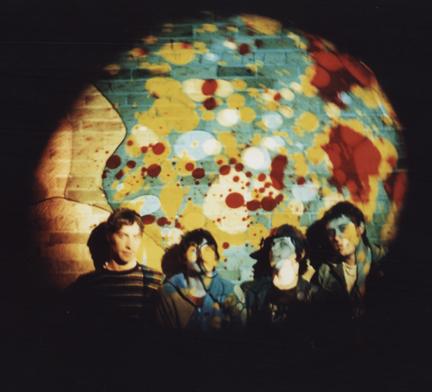
Enjoy!
Hippie Hippie Hoorah
It was quite a spectacle and a fun thing to be a part of. To commemorate I'm putting up a classic Lips song that they played in full acoustic glory - Hippie, Hippie, Hoorah.
PS: There were wigs, gold lame tights, and face paint far as the eye could see. grand.

Enjoy!
Hippie Hippie Hoorah
Monday, September 17, 2007
On the Horizon: Devendra Banhart
In a couple weeks freak-folker Devendra Banhart's newest sun bleached, acid washed LP, Smokey Rolls Down Thunder Canyon (Which was briefly and tentively title "Jewish Anarchy."), hits store shelves. It is a moody, crackly experiment in genre hopping between spanish lyrics against stripped down guitar, to some downright funky material. His signature warble returns in full force, however with a slightly deeper , richer quality to it. The songs are very strong on Smokey... There is the very Jim Morrison soaked Sea Horse... and the little diddy i'm posting out there for ya called "Shabop Shalom." Beginning with a spoken word intro bringing together two star crossed characters --- through Devendra's flowery vocabulary- then the song breaks into its waltzy goodness.
While some may have already written off Devendra as putting out his best material when he was only 21, this record finds him coming into his own and bringing his many influences to the table. I expect Devendra's best is yet to come. [CD Comes out 9/28 - pick it up.]

ENJOY.
SHABOP SHALOM
While some may have already written off Devendra as putting out his best material when he was only 21, this record finds him coming into his own and bringing his many influences to the table. I expect Devendra's best is yet to come. [CD Comes out 9/28 - pick it up.]

ENJOY.
SHABOP SHALOM
Sunday, September 16, 2007
Song for the day: The Next Best Thing.
For those of you who don't know, Aesop Rock just put out his tightest release to date on Def Jux at the end of last month. None Shall Pass is a real progressive step forward for Aes while much of the content is a reflection of where he's been. The album features tracks laid down by Blockhead and Aesop himself (whose seem to feature some real bass groove provided by the man himself.). This track is called The Next Best Thing and didn't make it on the album but is featured on the Coffee 12" and may sound familiar to those who picked up the 7" collaboration with Jeremy Fish. It's a sweet track featuring Aesop's signature stream of consciousness flow and urgent delivery. Try and keep up- and for those who can- check out his current tour featuring a well synced up video show as well as great support by Rob Sonic.

Enjoy.
THE NEXT BEST THING.

Enjoy.
THE NEXT BEST THING.
Saturday, September 15, 2007
A very eclectic first day on the Blog-o-sphere:
I wonder what place she got?
Gotta dig the slow-mo, multi-angle approach... that way every effect of gravity can be seen on our scantly clad uneven bar champ.
Perhaps a weekly pick of strange porno's would be a nice feature?
Gotta dig the slow-mo, multi-angle approach... that way every effect of gravity can be seen on our scantly clad uneven bar champ.
Perhaps a weekly pick of strange porno's would be a nice feature?
Obtuse Thoughts Early in the Day:
He sat under the muted lights of his small windowless room typing away at the keys in front of him. There was an electricity the air. Something beyond the parlance of words. Something that was an invisible presence in the room, like the anticipated ring of a stared at phone.
Still he smacked away at the keys hoping in vain that some answer would reveal itself through the symbols that when placed next to one another, constructed larger representations of objects, ideas and emotions on the screen. How, he wondered while pausing for a moment, could these feelings- this mood- transmit itself through the symbols, which when placed together in just the right way, create these larger representations, be interpreted by another soul, a reader?
Who was he writing for anyway? Does the word hold the key to understanding, and furthermore does that understanding mean anything if it is not read by others? Does the world truly fit into this narrow constraint of standardized communication we have constructed for ourselves? Perhaps. Perhaps just the action of doing was enough. Life through Creation, which sprinkled through the creative unconscious could prove to be strong enough to make a dent. If only on the internet. Suddenly he wasn't so alone in that windowless room.
Still he smacked away at the keys hoping in vain that some answer would reveal itself through the symbols that when placed next to one another, constructed larger representations of objects, ideas and emotions on the screen. How, he wondered while pausing for a moment, could these feelings- this mood- transmit itself through the symbols, which when placed together in just the right way, create these larger representations, be interpreted by another soul, a reader?
Who was he writing for anyway? Does the word hold the key to understanding, and furthermore does that understanding mean anything if it is not read by others? Does the world truly fit into this narrow constraint of standardized communication we have constructed for ourselves? Perhaps. Perhaps just the action of doing was enough. Life through Creation, which sprinkled through the creative unconscious could prove to be strong enough to make a dent. If only on the internet. Suddenly he wasn't so alone in that windowless room.
Hey Drrrtay!
Ahh the smell of fresh blog in the morning. For all intensive purposes this is to be my outlet for daily musings, stumbled upon media that should be shared, photos, songs, and whatever other nonsense flows forth from my brain, out through my finger tips and on to this screen.
In other words a direct link to you from me- and vice versa.
Today i want to share the joy of ridiculous cover songs. Follow the jump to check this bad boy out:
Here's a hint-
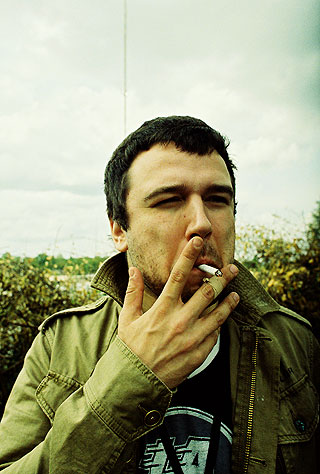
enjoy.
Got Yr Money!
In other words a direct link to you from me- and vice versa.
Today i want to share the joy of ridiculous cover songs. Follow the jump to check this bad boy out:
Here's a hint-

enjoy.
Got Yr Money!
Subscribe to:
Posts (Atom)
